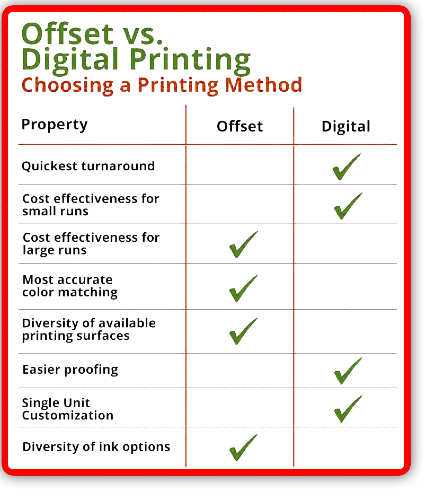Getting My Digital Printing To Work
Getting My Digital Printing To Work
Blog Article
Digital Printing Fundamentals Explained
Table of ContentsExcitement About Digital PrintingSome Known Factual Statements About Digital Printing The 3-Minute Rule for Digital PrintingThe Only Guide to Digital PrintingFascination About Digital PrintingDigital Printing for Beginners
Variable data printing, such as straight mail with personalized codes and addresses, is preferably fit for digital printing. Digital quick printing only needs four actions of layout, evaluation, printing and binding to obtain everything done. Digital fast printing has an unmatched advantage: print on demand.According to PMMI, digital printing permits brands and makers to respond promptly to client demands while enhancing the supply chain, lowering warehousing price and waste, and taking pleasure in faster time to market. That all audios excellent, but how does this modern technology do all that? The significant differentiator of these innovations is that there are no set up fees and no plates with digital printing.
Digital Printing for Beginners
This results in quicker turnaround time and lowers expense when using electronic printing.
Rapid production implies obtaining your item to market faster. It additionally indicates it's less complicated and faster to make changes later, when you alter a dish, include a SKU, or develop seasonal packaging. Digital printing is very adaptable, so it's easy to make modifications to the package layout swiftly. All of it goes back to the plates.
More stock can mean even more waste in the future. With traditional printing methods, short-run printing is simply not possible. Since an excellent design can make or damage your item, digital printing continually creates high-quality, clear and vivid graphics each time. Digital printing on flexible bags includes the bright, lively, and accurate graphics that almost beckon customers to connect and touch them.
Digital printing is the procedure of printing digital-based images straight onto a selection of media substrates. There is no requirement for a printing plate, unlike with countered printing. Digital files such as PDFs or desktop computer publishing documents can be sent straight to the electronic printing press to print on paper, picture paper, canvas, fabric, synthetics, cardstock and various other substratums.
Digital Printing - Questions
According to PMMI, digital printing allows brands and producers to respond promptly to consumer needs while enhancing the supply chain, minimizing warehousing expense and waste, and taking pleasure in faster time to market. That all noises excellent, yet how does this modern technology do all that? The significant differentiator of these modern technologies is that there are no set-up fees and no plates with digital printing.
According to Wikipedia, the greatest distinction in between electronic printing and standard approaches such as lithography, flexography, gravure, or useful link letterpress is that there is no demand to change printing plates in digital printing, whereas in these analog printing techniques the plates are repetitively replaced. This results in quicker turnaround time and decreases expense when making use of electronic printing.

Getting My Digital Printing To Work
More inventory can suggest more waste in the future. With traditional printing approaches, short-run printing is simply not feasible. Because an excellent layout can make or break your product, digital printing consistently creates top notch, clear and vivid graphics each time. Digital printing on flexible pouches includes the bright, dynamic, and accurate graphics that practically beckon customers to connect and touch them.

According to PMMI, electronic printing allows brand names and manufacturers to respond promptly to client needs while enhancing the supply chain, lowering warehousing expense and waste, and enjoying faster time to market. That all noises great, however just how does this technology do all that? The significant differentiator of these modern technologies is that there are no set-up charges and no plates with electronic printing.
Digital Printing Things To Know Before You Get This
According to Wikipedia, the best difference between digital printing and typical techniques such as lithography, flexography, gravure, or letterpress is that there is no requirement to change printing plates in electronic printing, whereas in these analog printing methods home plates are consistently changed. This leads to quicker turn-around time and decreases cost when utilizing electronic printing.
Digital printing is highly adaptable, click so it's easy to make changes to the bundle style swiftly. It all goes back to the plates.

The Digital Printing Diaries
Digital printing is the process of printing digital-based pictures directly onto a selection of media substrates. There is no demand for a printing plate, unlike with balanced out printing. Digital files such as PDFs or desktop computer publishing documents can be sent straight to the digital printing machine to print theoretically, photo paper, canvas, textile, synthetics, cardstock and other substrates.
Report this page